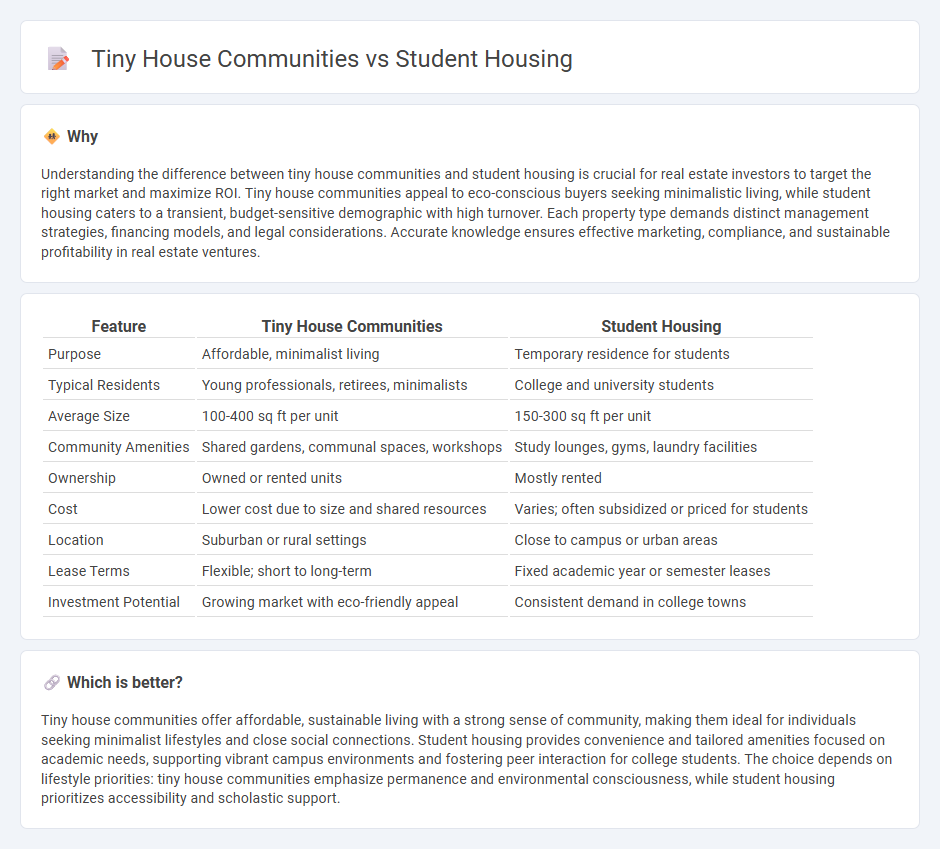
Tiny house communities offer an affordable, sustainable living option with a strong sense of community and minimal environmental impact. Student housing focuses on convenience and accessibility, providing amenities tailored to academic life and social engagement. Explore the benefits and challenges of each lifestyle to find the ideal housing solution.
Why it is important
Understanding the difference between tiny house communities and student housing is crucial for real estate investors to target the right market and maximize ROI. Tiny house communities appeal to eco-conscious buyers seeking minimalistic living, while student housing caters to a transient, budget-sensitive demographic with high turnover. Each property type demands distinct management strategies, financing models, and legal considerations. Accurate knowledge ensures effective marketing, compliance, and sustainable profitability in real estate ventures.
Comparison Table
| Feature | Tiny House Communities | Student Housing |
|---|---|---|
| Purpose | Affordable, minimalist living | Temporary residence for students |
| Typical Residents | Young professionals, retirees, minimalists | College and university students |
| Average Size | 100-400 sq ft per unit | 150-300 sq ft per unit |
| Community Amenities | Shared gardens, communal spaces, workshops | Study lounges, gyms, laundry facilities |
| Ownership | Owned or rented units | Mostly rented |
| Cost | Lower cost due to size and shared resources | Varies; often subsidized or priced for students |
| Location | Suburban or rural settings | Close to campus or urban areas |
| Lease Terms | Flexible; short to long-term | Fixed academic year or semester leases |
| Investment Potential | Growing market with eco-friendly appeal | Consistent demand in college towns |
Which is better?
Tiny house communities offer affordable, sustainable living with a strong sense of community, making them ideal for individuals seeking minimalist lifestyles and close social connections. Student housing provides convenience and tailored amenities focused on academic needs, supporting vibrant campus environments and fostering peer interaction for college students. The choice depends on lifestyle priorities: tiny house communities emphasize permanence and environmental consciousness, while student housing prioritizes accessibility and scholastic support.
Connection
Tiny house communities and student housing both address critical housing affordability and space efficiency challenges in urban areas. These living arrangements maximize limited land use by creating compact, community-oriented dwellings that reduce costs and foster social interaction. Real estate developers increasingly integrate tiny houses into student housing projects to provide affordable, flexible, and sustainable accommodation solutions.
Key Terms
Lease Agreement
Lease agreements in student housing typically involve fixed-term contracts aligned with academic calendars, often including utilities and campus amenities in the rent. Tiny house communities offer more flexible, month-to-month leasing options with personalized terms, catering to long-term sustainability and minimalism. Explore detailed comparisons to understand which lease arrangement best suits your lifestyle and housing needs.
Zoning Regulations
Zoning regulations for student housing typically involve specific allowances for high-density occupancy and shared living spaces near educational institutions, facilitating convenient access for students. Tiny house communities often face more restrictive zoning laws, frequently categorized under accessory dwelling units (ADUs) or requiring special permits due to their non-traditional structure and smaller footprint. Explore the nuances of local zoning codes to understand how each housing type navigates legal frameworks and residential planning.
Communal Amenities
Student housing often features communal amenities such as study lounges, fitness centers, and multipurpose rooms designed to enhance social interaction and academic support. Tiny house communities typically emphasize shared outdoor spaces, communal gardens, and workshops that foster collaboration and sustainable living. Explore more about how communal amenities shape lifestyles in student housing and tiny house communities.
Source and External Links
Student Housing at DePaul - Offers on-campus dorms, suites, and apartments for students, providing an instant sense of community.
Chicago Student Housing & Apartments - Provides various student housing options, including ensuites and studios in popular neighborhoods like Avondale and Wrigley Field.
Student Housing in Chicago - Features modern facilities like Infinite Chicago and Ion Lincoln Park, offering comfortable and convenient stays.
ForRentUniversity - Lists off-campus housing options near colleges, ranging from studios to 4-bedroom apartments.
Student Apartments for Rent in Springfield, IL - Offers a variety of student rentals, including private studios and shared apartments near colleges.
 dowidth.com
dowidth.com